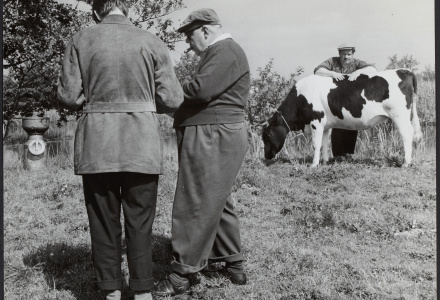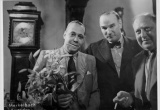Rudi Meyer and Joop Landré
There was a lack of continuity in the Dutch film industry in the 1950s. The occasional film that was made was more coincidental than intentional. If one disregards children’s films and dramatised resistance films, then there were only ten full-fledged feature films produced in the thirteen years after WWII, and these were made by eight different directors.
Gerard Rutten was the only director to make more than one of these ten films; in 1953 he was reponsible for Sterren stralen overal, in 1955 for Het wonderlijke leven van Willem Parel and in 1957 for De vliegende Hollander. Each of these ten films had different producers and different production companies, which further added to the lack of consistency. This absence of continuity – the inability to build up a basic level of experience – was seen by many as the reason for the mediocre quality of Dutch feature films in the mid-20th century.
It was no wonder, then, that there were many who called for change. Both the government and the Nederlandse Bioscoopbond took this call to heart and, at the end of 1956, the Productiefonds voor de Nederlandse Film was set up. From that point on, filmmakers could appeal to this official institution for financial support. In this way, it was hoped that some sort of continuity would be maintained. This was a first step toward a more fully developed film industry.
The first two producers who tried to build up a measure of continuity were an old hand and a newcomer to the film business. The first was Rudi Meyer and the other Joop Landré.
Rudi Meyer
Rudi Meyer had survived WWII in a concentration camp and, upon his return to the Netherlands, he picked up his old job as a film distributor. He was responsible for the release of Roma, città aperta and Paisa (both from Roberto Rossellini; 1945 and 1946), and he scored a big hit with the Sissi trilogy (Ernst Marischka, 1955-1957). In 1953 he produced his first post-war film: Sterren stralen overal by Gerard Rutten. The film drew 1.5 million viewers – in part thanks to the guest performance by the revue duo Snip & Snap, who were immensely popular at the time. Meyer’s next film would be his most successful: Fanfare, which was Bert Haanstra’s feature film debut. Two and a half million viewers saw this typically Dutch film about two rival bands competing against each other in the fictitious town of Lagerwiede.
Next, Meyer co-produced Haanstra’s new film De zaak M.P. and was the producer for both De overval and Kees Brusse’s Mensen van morgen. All of these successful films drew full houses – and that was one of Meyer’s great talents. He knew what audiences wanted and how to supply it without making too many concessions regarding quality, and without too much experimentation. Meyer was an old-school studio producer who was far removed from the young, up-and-coming filmmakers who were hitting the streets with their cameras.
Joop Landré
Joop Landré was a relative outsider in the world of the Dutch feature film. He had been director of the Rijks Voorlichtingsdienst (Government information service) and at Polygoon-journaal (Polygoon newsreels). It was there he became fascinated by the film world, and when he was offered the chance to become involved with it, he jumped in with both feet. Backed by money from shipping magnate Anton Veder, Landré started up his own production company: Nederlandse Filmproductie Maatschappij (NFM).
In 1960, his first film was released in cinemas and it was an instant hit: Makkers staakt uw wild geraas by Fons Rademakers. The reviews were positive and the film won a Silver Bear at the Berlin Berlinale. With 400.000 viewers, the turnout was reasonable as well, but it was too little to break even. His second film Het mes – also by Rademakers and adapted from a scenario by Hugo Claus – encountered the same situation, and he decided to change his strategy. He lowered his artistic standards slightly in order to make a couple of big blockbuster movies so that he could then return to producing more artistic films. He lacked the flair for success that Meyer had, however. Landré’s following productions were mediocre crowd-pleasers that drew attention mainly due to their unusual casting. In Rififi in Amsterdam, the judoka Anton Geesink played the main character; De vergeten medeminnaar was the film debut for stage actor Henk van Ulsen; and for the film 10.32, he brought Linda Christian, a Hollywood star with a Dutch background, to the Netherlands. None of these films was a success, however, and in 1966, the NFM was dissolved. By that time, Landré had already moved on to the Dutch television station TROS, where he became the new director.
With Meyer and Landré, the short interval in Dutch film history came to an end. They were followed by a group of eager young directors who were to produce their films in a very different way – thereby introducing a whole new sort of film in the Netherlands. These films reflected the fashion of their time: French nouvelle vague and Jungen Deutschen Film.
more information
If you are looking for more material from our collection, please contact Film Sales:
sales@eyefilm.nl
phone +31 (0)20 5891 426


